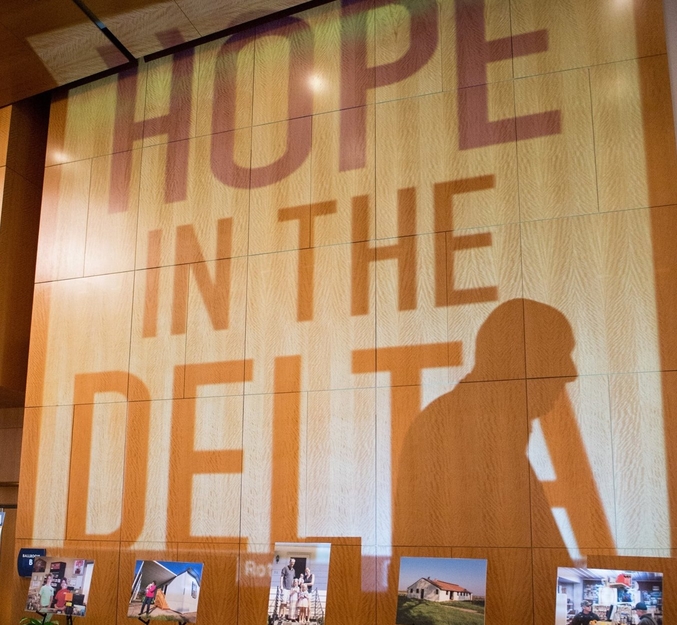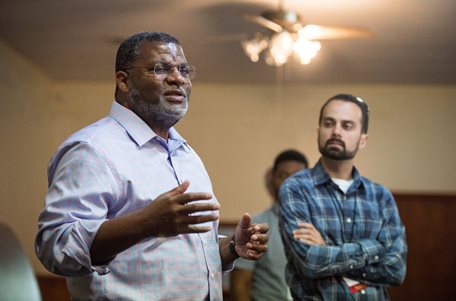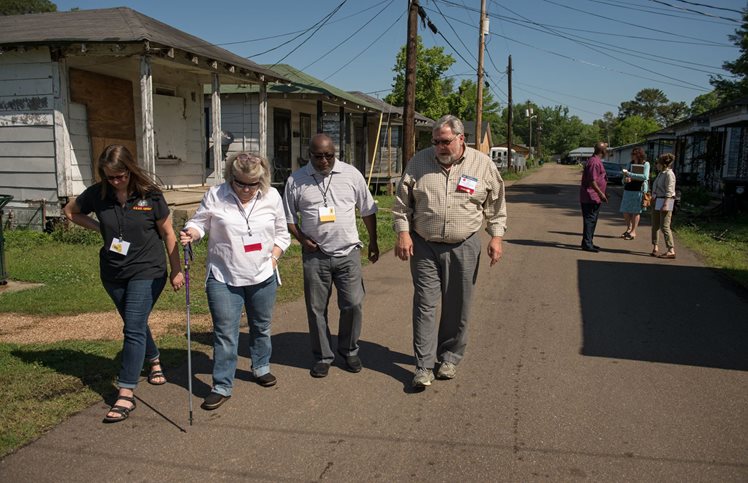 Broader access to financial education…internet-enabled communities…more living-wage jobs…greater private and governmental resources…making opportunities available to everyone. These are among the steps required to make a significant “dent” in persistent rural poverty, described by a mix of on-the-ground practitioners, funders and advocates. Idealistic? For sure. Still do-able? Yes, they said in two separate panels at the April 19-21 NeighborWorks America forum, “Hope in the Delta: Turning the Tide on Persistent Rural Poverty.”
Broader access to financial education…internet-enabled communities…more living-wage jobs…greater private and governmental resources…making opportunities available to everyone. These are among the steps required to make a significant “dent” in persistent rural poverty, described by a mix of on-the-ground practitioners, funders and advocates. Idealistic? For sure. Still do-able? Yes, they said in two separate panels at the April 19-21 NeighborWorks America forum, “Hope in the Delta: Turning the Tide on Persistent Rural Poverty.”
As Andrea Levere, president of the Corporation for Enterprise Development (CFED) put it, the central ingredients are hope and resources—whether the right education or a loan at an affordable interest rate. We just have to give people what they need to succeed
Here are some highlights of what the panelists said is needed, and what gives them hope we can make these achievements happen:
Education and employment
Expanded education is vital in so many ways, and the barriers are varied as well. Levere recounted visiting one rural community in which she found children and parents sitting on the steps of the local school at 9 p.m. because it was the only place they could get wifi to do their homework. More equitable distribution of technology, particularly broadband access, also is a theme in the white paper issued prior to forum. Programs and requirements like the Community Reinvestment Act, which mandates that financial institutions invest in their communities, could perhaps be leveraged to bring more resources to rural areas for such infrastructure, as well as fill other gaps.Chrystel Cornelius, executive director of First Nations Oweesta Corp., the only national intermediary for Native-American CDFIs, focused on another need: financial literacy education. “In remote areas, the only access to cash when needed is through predatory lenders,” she said. “And there are so many other challenges that can be addressed in part by education. Because Native lands and other rural areas are so remote, we’ve employed a train-the-trainer approach. So far, we’ve trained 16,000 instructors, who will in turn educate others.”
However, it’s not just instruction and coaching for residents that’s needed. It’s also important to educate “outsiders” about the realities of rural areas and the people who live there. The Community Development Corp. of Brownsville, Texas, serves the “colonia” communities along the border with Mexico. Executive Director Nick Mitchell-Bennett pointed out that immigrants contribute significantly to the local economy, but that reality isn’t widely known.
“Many communities would see a loss if it were not for immigrant and day laborers. We have a responsibility to educate others about their contribution,” he said, adding that when professionals go out into the community and beyond, they must remember to avoid “insider jargon”— the numerous acronyms and program names.
The bottom line: Education and access to technology both are essential to providing jobs that pay a living wage.
“Fundamental to creating opportunity in places of persistent poverty are strategies for creating jobs, linking to jobs and helping people prepare for jobs,” observed NeighborWorks CEO Paul Weech. “It is imperative that we pay more attention to the linkage between community development and economic development.”
Equitable opportunity
One of the forces hindering advancement in these areas is an unequal distribution of resources and opportunity, according to the panelists.
Resources and partnerships can help, but they must be intentionally “invested” so they benefit everyone.
Resources
As all of the panelists pointed out, both public and private investments are needed.“People can do anything if they have the tools. But you can’t get blood from a turnip,” Bill Bynum, CEO for HOPE, reminded the audience. “We must equip them to succeed. We have to invest in them.”
The market is dysfunctional in the country’s pockets of persistent poverty, the panelists observed, and one step required to attract the necessary investment is to counteract the erroneous stereotypes about the “riskiness” of rural business.
“In 10 years of operation, we’ve only had one default,” said Cornelius. “That’s a default rate 0.001 percent!”
Levere sees the role of CDFIs as making markets work for these neglected areas of the country. One imperative, she agreed, is to mine existing data and use it to produce evidence that disproves the myth of risky customers. For example, data could make the case to consider on-time rent payments the same way home mortgages are when calculating credit scores.
Likewise, Weech pointed out, the nonprofit sector is increasingly moving into social enterprise business models to show they can work in rural areas, and do so profitably. “The private sector can then learn from us,” he said.
In fact, Beth Marcus, who leads resource development for the Local Initiatives Support Corp., reported that LISC now is one of three rural-serving institutions rated by Standard & Poor’s, along with bottom-line businesses.
Resident leadership and partnerships
Although everyone agreed external investment is essential, they also were unanimous in saying local residents and organizations must partner to lead the way.“We all know what works,” said Jim King, president of the 55-member Fahe. “As the saying goes, if you want to go fast, go alone. If you want to go far, go with friends. But it takes effort. It takes time. And we need all the parties at the table.”

The bottom line, agreed Moises Loza, executive director of the Housing Assistance Council, is that you have to be in for the long haul, together.
“No one on this panel started last month,” he said. “We have to continually learn and choose what works for our communities. We need to learn lessons from each other.”
There have been too many natural disasters, recalled King, when outside agencies and resources showed up in the immediate aftermath, “but by the time we got to phase 3, when people were trying to rebuild their lives, you looked around and thought, how did it get so lonely here? This is why we have to bring down our silos and own our fate. Fortunately, relationships are a natural rural asset, often overlooked. We know we’ll need our neighbor one day and we know how to work together. ”
Marcus agreed with the imperative of collaboration, but warned that an effective partnership requires a person charged with making it run smoothly. And that means someone needs to be paid to do it—a fact too often overlooked.
One of the most positive trends in community development related to partnership, added Mitchell-Bennett, is self-help housing, in which the future owners not only help design their home but help build it.
“When you sit with someone who has never been asked what they want, it is phenomenal to watch,” he said. “We have taken choice away from the people we serve and we need to give it back.”
Reasons for hope
Marcus pointed to a woman she met during one of the forum’s regional tours who not too long ago was told she wasn’t allowed in an upper-class neighborhood to look at Christmas lights. Today, however, she is mayor of the community.Mitchell-Bennett recounted a story: When he first began working at the CDC of Brownsville, he noticed that all of the houses had piles of bricks by them; some simply had larger piles than others. When he inquired about their purpose, he was told that as soon as residents had accumulated enough, they would be used to finish off the sides of their houses, to make them more attractive. “Now, that’s hope in action,” he said. “No matter what today’s reality, they believe the future will be better.”
King cited the sheer number of innovative projects showcased at the forum. “There are things happening!” he exclaimed.
Bynum looked around the room and said, “You are my hope. My allies.”

